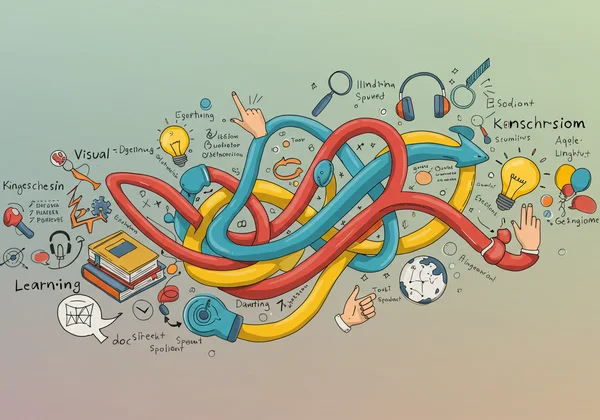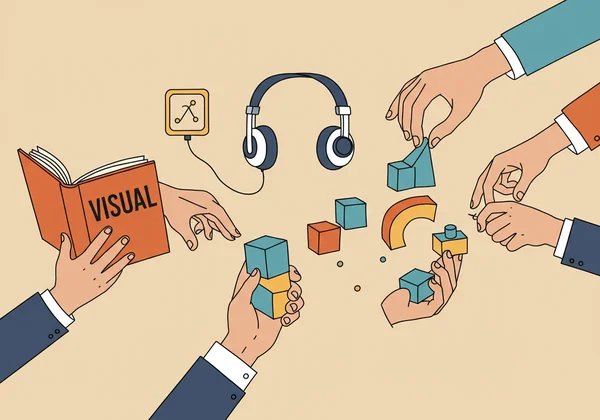Discover Your Blended Learning Style with Our Quiz!
Have you ever taken a test that labeled you "just a visual learner," even though you know you also love listening to podcasts and working with your hands? If you've ever felt limited by a single learning style label, you're not alone. The truth is, most of us are a rich tapestry of learning preferences. This guide explores why you are likely a unique mix, and how understanding your blended learning style can unlock more effective, engaging, and enjoyable learning. What kind of learner am I, really?
The journey to answering that question is the first step toward transforming how you study, teach, or approach new skills. Instead of trying to fit into a neat little box, you can learn to leverage your personal combination of strengths. Ready to uncover your unique profile? You can discover your results on our free, no-registration learning style quiz.

Understanding Your Blended Learning Style
While a single, dominant learning style is a useful starting point, it rarely tells the full story. Human psychology is complex and dynamic. We don’t operate in just one mode. Embracing a blended learning perspective means acknowledging that you have a primary style supported by secondary preferences that you use in different situations. This nuanced view is far more empowering and practical for real-world application.
The Reality: Why Most Learners are Mixed Types
Think about how you learn to cook a new recipe. You might watch a video (Visual), listen to the instructions (Auditory), and then physically chop the ingredients (Kinesthetic). You're not consciously switching styles; you're naturally using a blend that works for the task at hand. Most educational psychologists agree that while we may have a stronger inclination toward one style, we are all mixed types of learners. Recognizing this is key to building a flexible and powerful toolkit for acquiring new knowledge.
Beyond Simple Labels: Visual, Auditory, Kinesthetic, and More
The most widely recognized learning styles form the VAK model: Visual, Auditory, and Kinesthetic. These aren't rigid categories but rather fundamental building blocks of how we process information.
- Visual Learners tend to prefer charts, diagrams, and written information. They often remember what they see.
- Auditory Learners thrive on listening to lectures, participating in discussions, and using rhymes or music to remember concepts.
- Kinesthetic Learners learn best by doing. They need hands-on activities, experiments, and physical movement to truly grasp a topic.
Your blended style is your unique recipe using these ingredients. You might be 50% Visual, 30% Kinesthetic, and 20% Auditory. Understanding this specific mix is where the magic happens, allowing you to create learning strategies that cater perfectly to you.
How to Identify Your Unique Mixed Learning Styles
Pinpointing your personal blend of learning styles is a process of self-discovery. It involves both structured assessment and mindful self-observation. The goal is to gather insights that you can turn into actionable strategies for more efficient learning, whether you're a student, educator, or lifelong learner.
The Role of a Learning Style Quiz in Self-Discovery
The fastest and most insightful way to begin your self-discovery is by taking a well-designed assessment. A high-quality learning styles quiz can analyze your responses to various scenarios and provide a clear, data-driven profile of your preferences. Our platform, refined with data from over 1.4 million users, offers a free learning style quiz that gives you immediate insights into your VAK profile without any need to register. It serves as a fantastic starting point for understanding your cognitive strengths.

Observing Your Natural Preferences in Action
Beyond a quiz, pay attention to your habits. When you need to learn something new, what do you do first?
- Do you immediately search for a YouTube tutorial or an infographic? (Visual)
- Do you prefer to have someone explain it to you or listen to a podcast on the topic? (Auditory)
- Do you feel an urge to just dive in and try it out, learning through trial and error? (Kinesthetic)
Keeping a simple journal for a week can reveal powerful patterns about your natural preferences. Note which activities make you feel engaged and which ones feel draining. This personal experience, combined with the objective results from our VAK test, provides a comprehensive view of your blended learning style.
Actionable Strategies for Combining VAK Styles
Once you've identified your unique blend, you can stop forcing yourself into methods that don't work and start creating a study environment that plays to all your strengths. The goal is to combine VAK styles into a cohesive and dynamic approach that makes learning feel intuitive and effective.
Embracing Multi-Modal Learning Techniques
Multi-modal learning simply means using multiple senses and methods to engage with material. This is the ultimate strategy for the blended learner. Instead of just reading a chapter in a textbook, try these multi-modal learning approaches:
-
Read and Visualize: After reading a section (Visual), close your eyes and try to visualize the concepts as a flowchart or a scene. Then, sketch it out.
-
Listen and Do: Listen to a lecture or a podcast (Auditory) while taking notes by hand or building a small model related to the topic (Kinesthetic).
-
Watch and Discuss: Watch a documentary (Visual/Auditory), then explain what you learned to a friend or study partner (Auditory).

Tailoring Your Study Habits for Optimal Retention
To achieve optimal retention, integrate your styles. If you're primarily a Visual learner with a strong Kinesthetic side, don't just create flashcards—create them using different colored pens and physically arrange them into mind maps on your floor. If you're an Auditory-Kinesthetic learner, try pacing around your room while listening to an audiobook and summarizing key points aloud. The key is layering techniques to keep your brain fully engaged. Start your journey to better study habits today.
Success Stories & Next Steps in Your Learning Journey
Understanding your blended style is not a one-time fix but the beginning of an exciting learning journey. It's about giving yourself permission to learn in the way that feels most natural and effective for you. This empowers you to take control of your education and professional development.
Real-World Examples of Blended Learners Thriving
Consider a college student who discovered she was a Visual-Auditory learner. Instead of just re-reading her notes, she started recording herself summarizing the key points and listening back to the recordings while reviewing her visual mind maps. Her grades improved because she was finally studying in a way that aligned with her brain's wiring. Or think of the professional who realized his Auditory-Kinesthetic blend meant he learned best from interactive workshops, not from reading manuals. These are real-world examples of people thriving by embracing their unique mix.
Continuous Improvement: Evolving Your Learning Approach
It’s crucial to remember that learning styles are preferences, not permanent traits carved in stone. Your preferences might shift depending on the subject matter, your age, or even your mood. The most successful learners are those who are evolving your learning approach continuously. Re-check your style every year or so, stay curious, and never stop experimenting with new techniques. This mindset of continuous improvement is the hallmark of a true lifelong learner.
Unlock Your Full Learning Potential
You are not just one thing. You are a dynamic, adaptable, and unique learner with a powerful blend of styles. By moving beyond simplistic labels and embracing your personal mix of Visual, Auditory, and Kinesthetic preferences, you can make learning more intuitive, effective, and enjoyable. It's time to stop fighting against your natural tendencies and start leveraging them for success.
Are you ready to discover your unique learning superpower? Take our quick, free, and insightful learning style quiz right now. It takes just a few minutes to get a personalized report that can change the way you learn forever.
Frequently Asked Questions About Blended Learning Styles
What kind of learner am I if I have a blended style?
If you have a blended style, you are a versatile and adaptable learner! It means you draw strengths from multiple learning modalities—Visual, Auditory, and Kinesthetic. For example, you might be a "Visual-Kinesthetic" learner, meaning you learn best when you can both see information and interact with it physically.
How do you identify your specific blended learning style?
The best way is a two-pronged approach. First, take our free quiz for an objective, data-backed analysis of your preferences. Second, practice self-observation by noticing which learning activities energize you and which ones feel difficult. Combining these two methods will give you a clear and accurate picture.
Is one learning style more effective than others?
No, there is no "best" or "most effective" learning style. The effectiveness of a style is entirely dependent on the individual and the learning context. What matters is identifying your most effective blend and using strategies that align with it. A balanced approach that incorporates multiple styles is often the most powerful.
Can my learning style change over time?
Absolutely. Your learning preferences can evolve with age, experience, and the subject you are studying. A task might demand a different approach, or you might develop a new appreciation for a style you previously used less. It's a good practice to reassess your learning style periodically to ensure your strategies remain effective.
What are some examples of multi-modal learning techniques?
Multi-modal techniques engage multiple senses at once. Examples include watching a how-to video and following along with the steps, creating a presentation with both images and a spoken script, using color-coded notes to organize information from a lecture, or building a physical model to represent a scientific concept you've read about.